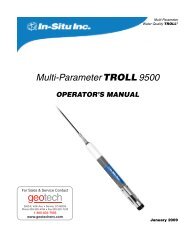TEST INSTRUCTIONS - Geotech Environmental Equipment
TEST INSTRUCTIONS - Geotech Environmental Equipment
TEST INSTRUCTIONS - Geotech Environmental Equipment
You also want an ePaper? Increase the reach of your titles
YUMPU automatically turns print PDFs into web optimized ePapers that Google loves.
IRON–UDV<br />
BIPYRIDYL METHOD–UNIT DOSE VIALS CODE 4315-H<br />
QUANTITY CONTENTS CODE<br />
1 *Iron Unit Dose Vials, 10 pouches *4315-H<br />
*WARNING: Reagents marked with an * are considered hazardous substances. To<br />
view or print a Material Safety Data Sheet (MSDS) for these reagents see MSDS CD<br />
or our web site. To obtain a printed copy, contact us by e-mail, phone or fax.<br />
<strong>Equipment</strong> needed but not supplied:<br />
STANDARD ACCESSORY PACKAGE CODE 1961<br />
1 Package of 3 Vials (empty) 0156<br />
1 Syringe, 6 mL, plastic 1184<br />
1 Foil Storage Bag 9467<br />
Or:<br />
ADVANCED ACCESSORY PACKAGE CODE 1962<br />
1 Pipettor 30528<br />
1 Pipet Tip (0-5 mL) 30695<br />
1 Cuvette Rack 31695<br />
1 Package of 3 Vials (empty) 0156<br />
1 Foil Storage Bag 9467<br />
Most natural waters contain some iron. Its presence may vary from small traces<br />
to very large amounts in water which is contaminated by acid mine wastes. For<br />
domestic use, the concentration should not exceed 0.2 ppm and for some<br />
industrial applications not even a trace of iron can be tolerated. There are<br />
many means available for removing or reducing iron content. Water softening<br />
resins are effective for removing small amounts of iron and special ion<br />
exchange materials are selective for iron removal. High concentrations of iron<br />
can be removed by such chemical processes as oxidation and lime or lime-soda<br />
softening. Because of the many means of removing or reducing the amount of<br />
iron in water, the particular method employed will depend largely on the form<br />
of iron which is present and the end use of the treated water.<br />
APPLICATION: Drinking, surface, and saline waters; domestic and industrial<br />
wastes.<br />
RANGE: 0.00–10.00 ppm<br />
METHOD: Ferric iron is reduced to ferrous iron and subsequently forms<br />
a colored complex with bipyridyl for a quantitative measure<br />
of total iron.<br />
Smart2 <strong>TEST</strong> PROCEDURES 2.04 Iron–UDV 1/3

















